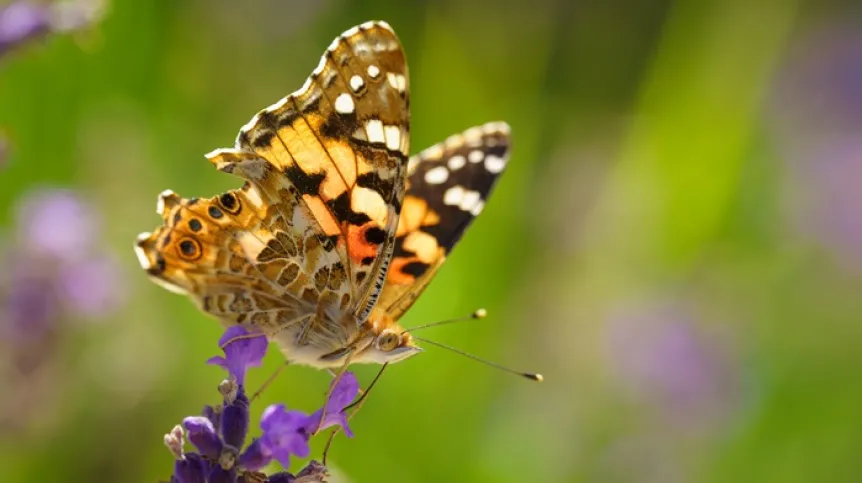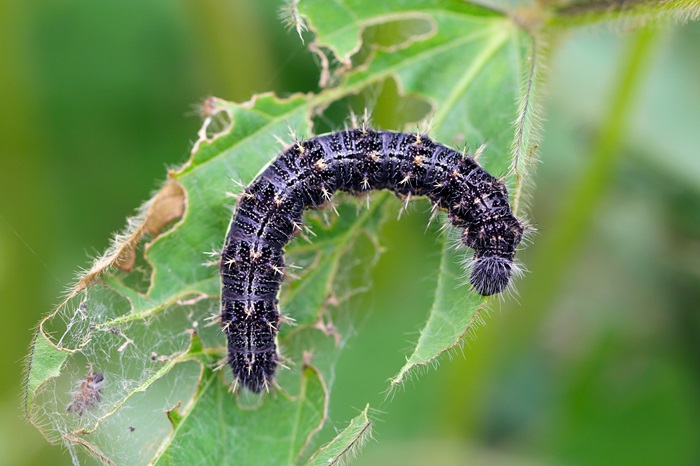
Butterflies are associated with fragility, but they can fly several thousand kilometres using air currents, among other things. Their migrations are still poorly known, however, and they cannot be tracked as easily as birds, using rings or GPS transmitters, says botanist and ecologist Dr. Tomasz Suchan.
Dr. Suchan is the co-author of the recent discovery of the longest documented flight of butterflies (10.1038/s41467-024-49079-2). In an interview with PAP, he talks about how using modern technologies, including his method of sequencing plant pollen, allows him to track the insects and learn completely new things about them.
'We calculated that without using wind, with the power of their own wings, butterflies are able to fly about 780 km without food. However, using air currents, they can fly even several thousand kilometres and cross the Atlantic. They perform such a flight in one go, it takes 5-8 days', Suchan from the W. Szafer Institute of Botany of the Polish Academy of Sciences.
The study published in Nature Communications, of which he was the first author collaborating with scientists from Spain, Canada and the USA, concerned the migration of a species common in Poland, but also in most regions of the world, the painted lady (Vanessa cardui). This cosmopolitan butterfly occurs in North America, Africa, Europe and Asia, but not in South America. 'There are individual observations of it there, but we know that there are no permanent, reproducing populations on that continent', says Dr. Suchan.
EVIDENCE ONE: SEQUENCING PLANT POLLEN
The whole story began when in 2013, Spanish biologist Dr. Gerard Talavera managed to catch several specimens of the painted lady on a beach in French Guiana (northeastern South America). Knowing that this was not their usual place of habitation, he decided to check where they came from. To this end, he sent them to Dr. Suchan's laboratory in Kraków.
'At that time, our team was developing a method for sequencing pollen collected from butterflies. We assumed that if we succeeded, it would be a good tool for tracking insect migration. It looks like butterflies stop in different places to feed, and when they drink nectar from flowers, pollen is deposited on their bodies. By examining the species composition of pollen, we can determine where insects were feeding', says Suchan.
Using a technique called metabarcoding determined that the butterflies collected in Guyana had come from Africa, because pollen from that location was detected on them.
'This was the first signal that we had discovered something interesting; that perhaps these butterflies had flown from Africa to South America', Suchan says.
EVIDENCE TWO: WIND ANALYSIS
The researchers decided to verify this with further analyses. 'First, we checked what winds were blowing in this region of the world at the time. It turned out that in the days preceding the capture of the butterflies, there were winds from Africa, which could have helped disperse these individuals', Suchan continues.
EVIDENCE THREE: GENETIC TESTS
'We also performed genetic tests. This is one of the reasons why this research took so long. Because in order to have solid material for them, we had to collect specimens of this species from all over the world. We had individuals from North America - from the United States and Mexico, from all over Europe and a large part of Africa', he adds.
It turned out that the butterflies could be divided into two genetic groups: European-African and North American. According to Dr. Suchan, the painted lady is a migratory species, which is why there are no genetic differences between individuals caught in Europe and Africa - it is one population that regularly moves between the two continents. However, subtle differences occur between butterflies from North America and the European-African population. 'It turned out that the specimens caught in French Guiana belonged to the latter group. This was another - third - piece of evidence confirming their dispersal across the Atlantic', says Suchan.
EVIDENCE FOUR: ISOTOPIC COMPOSITION OF WINGS
In addition, the authors of the study decided to examine the isotopic composition of the butterflies' wings. Dr. Suchan explains that it reflects the place where the insects underwent development, i.e. where the larvae fed. Each region of the world has a specific composition of isotopes, depending, among other things, on rainfall, soil type, etc. These isotopes are incorporated into plants growing in a given region, and then into the tissues of caterpillars feeding on them.
The scientists used two hydrogen isotopes, which determine the approximate latitude, and strontium isotopes, which pinpoint the location even more precisely. Ultimately, it was determined that the isotopic composition of the butterflies' wings was characteristic of Europe and North Africa. However, according to the researchers, it was closer to that of Europe.
LONG-DISTANCE FLIERS
'If these butterflies came to South America from Africa, their flight across the Atlantic was 4,200 km long. However, we consider it highly probable that they came from Western Europe, which would mean that they flew as much as 7,000 km in one generation', says Dr. Suchan.
Outlining a possible scenario for such a migration, he says it is most likely that the painted lady caterpillars developed in Western Europe and pupated there, and the adults flew across the Mediterranean Sea, the Sahara, stopped on the coast of Central Africa, fed on local plants, and then were carried away by the wind near Senegal and flew on it to French Guiana.
When asked why the painted lady only accidentally wanders to South America and does not establish permanent populations there, Suchan says that it is probably due to unsuitable climatic conditions and a lack of host plants.
Both of these factors are what make the painted lady a migratory species. 'They cannot overwinter in Poland at any stage of their development, like some other butterflies do. This species does not have a diapause stage, so it must follow the availability of host plants. Therefore, in spring it migrates from Africa to Europe, because in the dry season the availability of food drops significantly; they spend the entire summer here, and in autumn they return: first to North Africa, then to Central Africa. So we have many generations, each of which develops in a different place', says Dr. Suchan.

BUTTERFLIES ARE NOT EASY TO TRACK
The scientist explains that butterfly migrations are still very poorly understood. Insects cannot be tracked as easily as birds, for example. 'We can put rings and GPS transmitters on birds, and in the case of butterflies, all we can do is observe their appearances in different locations', he says.
It is known that butterflies use both active flight and air currents during their migrations.
However, long migrations are a huge burden for them: the individuals that were found in Guyana were heavily damaged. 'The ones that we observe in Poland fresh after metamorphosis have bright colours and beautiful wings. Butterflies from Africa, or even more so the ones from South America, had completely worn-off scales, they were faded, and their wings had numerous damages', the researcher says.
The Polish scientists now want to develop and use their method of examining pollen to also track other issues related to insect migration. It is an excellent starting point for many interdisciplinary studies. (PAP)
Katarzyna Czechowicz
kap/ zan/ ktl/
tr. RL













